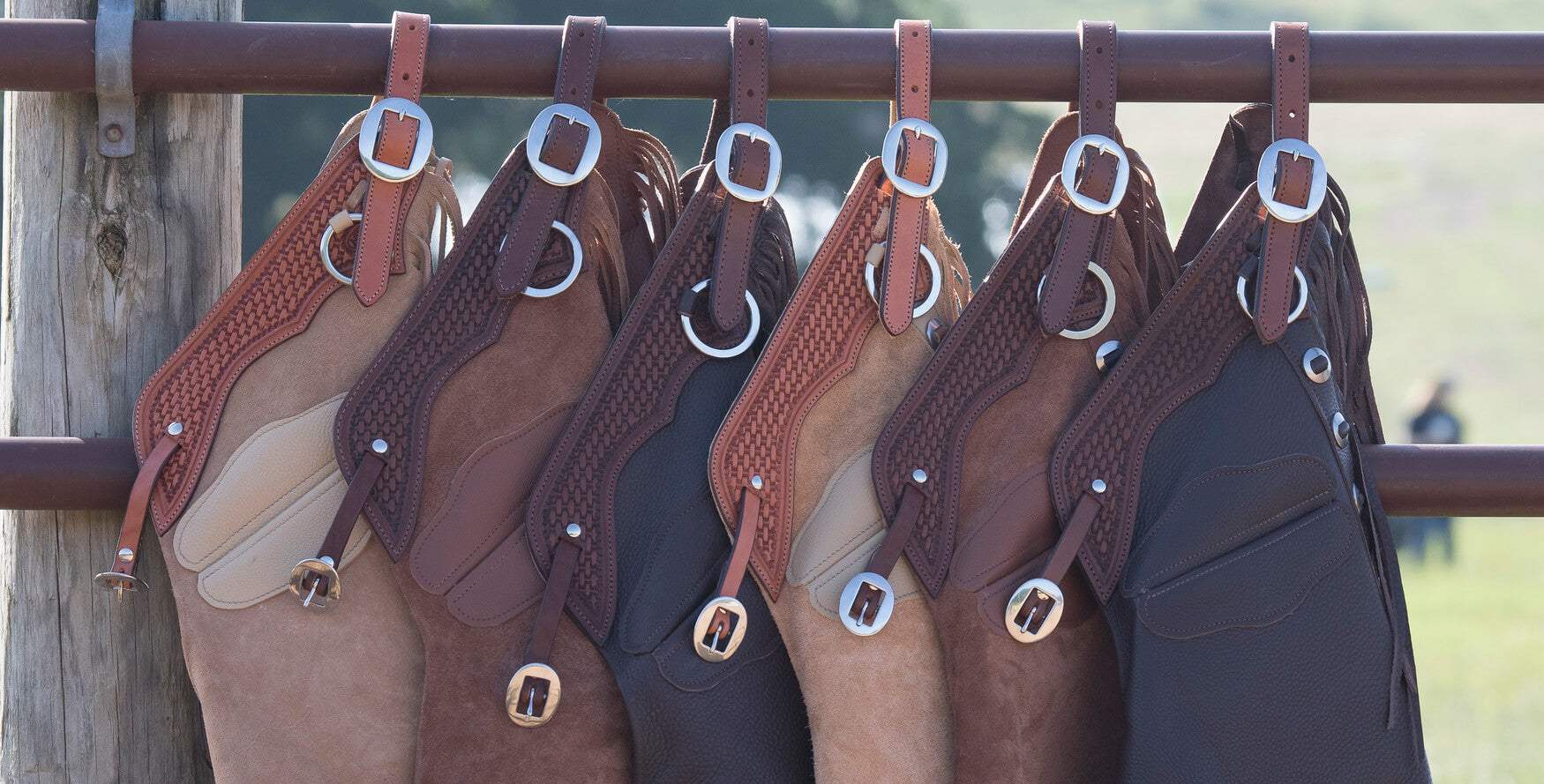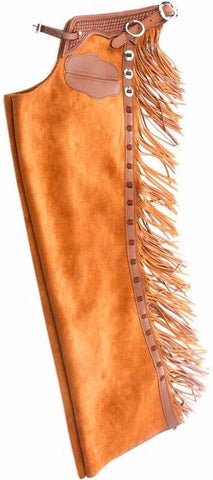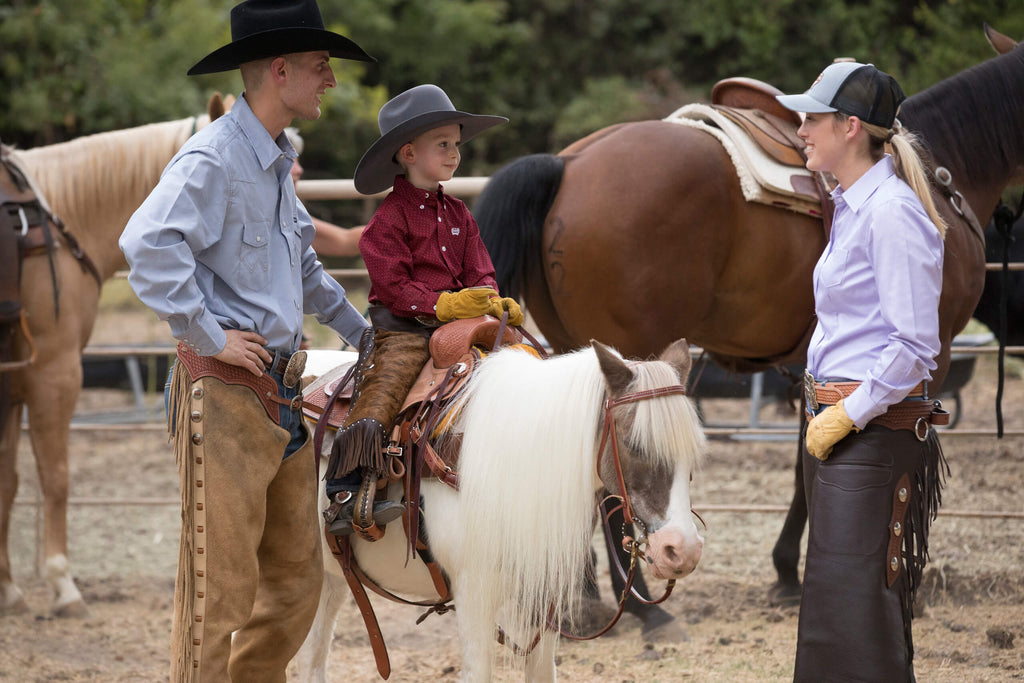
The Evolution and Significance of Cowboy Chaps
The iconic Western symbol of the Wild West! Leather cowboy chaps hold a profound history and serve a practical purpose in the Western industry.
Cowboy Chap History
The origin of chaps can be traced back to the working cowboys of the American West during the late 19th century. These horsemen traversed rugged terrains, enduring harsh weather conditions while tending to cattle herds across vast expanses of land. In such demanding environments, protection against elements like thorns, brush, and inclement weather became imperative.
Chaps, short for "chaparreras," were born out of necessity. Crafted from durable leather, these leg coverings provided a shield against the hazards of the trail. Their design typically consisted of sturdy leather panels, fastened around the waist and secured along the legs, offering a protective layer that guarded against abrasions and potential injuries during long rides through rough terrain.
Practicality of Chaps
Beyond their aesthetic appeal, cowboy chaps serve practical functions essential for the demanding cowboy lifestyle:
Protection from Elements: The rugged leather of chaps acted as a barrier, shielding the rider's legs from thorny bushes, sharp rocks, and adverse weather conditions like rain or wind.
Safety and Durability: By safeguarding against scratches, cuts, and scrapes, chaps provided a layer of defense, enabling cowboys to work in challenging environments without compromising their safety.
Heat and Cold Resistance: In colder climates, chaps provide added insulation, keeping the lower body warm during chilly rides. Conversely, in scorching heat, they prevented chafing and protect against sunburn.
Chap Evolution
While the practicality of chaps remains relevant, their significance has grown the realm of functionality to become an emblem of cowboy culture and identity. As cowboy lore permeated popular culture through literature, movies, and folklore, chaps evolved into a powerful symbol of the intrepid spirit, independence, and resilience associated with the cowboy way of life.



Even today, beyond their utilitarian purpose, cowboy chaps persist as an integral part of Western fashion, worn not just by working ranch hands but also by rodeo performers, enthusiasts, and individuals seeking to embrace the spirit of the Wild West.
Types of Chaps
There are several types of chaps, each designed to serve specific purposes and cater to different activities within the realm of horseback riding and Western culture.
SHOTGUN - These are close-fitting chaps that cover the entire leg and are often worn by cowboys and working ranchers. They have minimal fringing and offer extensive protection against thorns, brush, and harsh weather.
SHORT - Short chaps are much shorter than shotgun chaps, typically ending above the knee or calf. They offer protection to the lower leg while allowing more freedom of movement. Short Chaps are popular among rodeo competitors and riders who require agility, such as calf ropers or cutting horse riders.
BATWING - Known for their wider, more flared design, batwing chaps offer a larger area of coverage, providing increased protection. They were commonly used by cowboys in areas with dense vegetation or by those handling wilder cattle.
HALF - Popular in English riding disciplines, half chaps cover only the lower leg, from the ankle to below the knee. They're often made of suede or leather and are designed to be worn over paddock boots. Half chaps provide added grip and protection while riding.
RODEO - Rodeo chaps vary widely in style and design, often reflecting the individuality and flair of the rider. They can be adorned with fringes, elaborate designs, or personalized with team logos or colors. These chaps are primarily worn by rodeo competitors during events like bull riding, barrel racing, and bronc riding.
Each type of chap caters to specific needs, riding disciplines, and personal preferences, showcasing the diversity within the realm of Western wear and riding attire. From traditional working chaps meant for durability and protection to stylized versions that celebrate individuality, the variety of chaps reflects the evolution of their purpose and their significance in Western culture.
How to Wear Cowboy Chaps
Here is a step-by-step guide on how cowboy chaps are typically worn:
-
Wear appropriate clothing, such as jeans or trousers, before putting on chaps. This ensures comfort and proper fitting of the chaps.
-
Adjust the belt! Cowboy chaps typically have a belt or strap that goes around the waist. Fasten the belt securely around your waist, ensuring a snug but comfortable fit.
-
Hold the chaps by the belt or waistband and step into them one leg at a time. Pull them up over your jeans, positioning them so that the front of the chaps covers the front of your thighs, and the back covers the back of your legs.
-
Depending on the design of the chaps, there will be fastenings to secure them around your legs. This might involve snaps, buckles, or ties. Ensure that these fastenings are properly secured to keep the chaps in place.
-
Once the chaps are fastened, make minor adjustments to ensure they fit comfortably. They should allow freedom of movement while riding or walking. Check that they aren’t too tight or restrictive around the knees or thighs.
Before mounting your horse or engaging in any activity, double-check that the chaps are securely fastened. This ensures they won’t shift or become loose while riding. Once you're in the saddle, do a final check to ensure the chaps remain in place and don’t impede your movements. Make any necessary adjustments for comfort and safety. After riding you’ll want to carefully remove the chaps by undoing the fastenings and taking them off one leg at a time. You'll want to hang them properly to maintain their shape and condition for future use.







